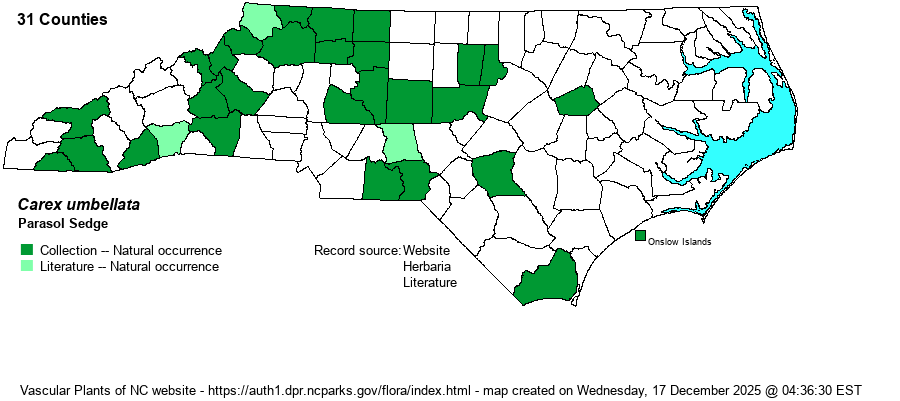| Author | Schkuhr ex Willdenow | |
| Distribution | Mostly in the Piedmont and Mountains, but with gaps; rare in the upper Coastal Plain, and very rare toward the coast (i.e., Brunswick and Onslow counties). Most gaps will likely be filled with additional collecting. In 2022 Derick Poindexter annotated all specimens of this species group at NCU herbarium; they represent Alleghany, Brunswick, Onslow, Orange, Randolph, Richmond, and Rowan counties. That is only 7 counties; the other 21 counties on our map are at other herbaria and need their specimens double-checked for ID.
Newf. to Sask. south to SC, TN, IL, and MN. | |
| Abundance | Uncommon to frequent in Mountains and Piedmont; rare in the Coastal Plain. The website editors suggest a State Rank of S3S4. | |
| Habitat | Open, dry to mesic, sandy to clayey, fields, slopes, sunny ridges. Habitats in NC are not well-known as yet. The Brunswick County collection is from a savanna. | |
| Phenology | Flowering and fruiting March-May. | |
| Identification | In the field Parasol Sedge appears as a short tuft of leaves with flowering stems generally hidden within. Thus, it may be passed by without notice. It is very close to C. tonsa and C. rugosperma, but differs in its shorter perigynia (2.2-3.2 mm long vs. 3.1-4.7 mm long). | |
| Taxonomic Comments | Formerly lumped with C. tonsa.
The genus Carex is the largest in North America, and among the largest in the world. In temperate and boreal regions, Carex is often the dominant or co-dominant ground layer in many habitats. Seeds (achenes) are valuable food for birds and small mammals, while foliage is used by birds and mammals to make nests and as food by mammals. Species of Carex often look vastly different from one another -- spikes erect vs. drooping, tiny inflorescence vs. whopping, culms leafy vs. naked, perigynia beaked vs. beakless, stems densely bunched vs. single, etc. The genus has been divided into many sections (or groups), based on shared characters; some taxonomists have suggested that these be different genera, but that proves unworkable (so far). All Carex share the feature of a perigynium (an outer covering) which completely surrounds the achene (seed). This covering may fit tightly or loosely (like a small bladder), depending on which group or species. Details of perigynia shape, ornamentation, presence and size of beak, number of striations (or veins) are all important ID features. In recent years Rob Naczi and colleagues have stressed the importance of arrangement of perigynia -- whether spiral (3+ ranks) or distichous (2-ranked) -- and have named a number of new species as well as split off some older synonyms. Therefore, RAB's (1968) key, excellent for its time, can only be used in a general way today. Members of some sections of Carex are difficult to key out (notably Ovales, Laxiflorae, Griseae); this is in part due to variation among individuals of a species, or failings of the key. FNA has drawings of most species and some species may be found in two or more places within a key, to acount for variability. New species to NC, and new to science(!), continue to be found in NC. | |
| Other Common Name(s) | Low Sedge | |
| State Rank | [S3S4] | |
| Global Rank | G5 | |
| State Status | | |
| US Status | | |
| USACE-agcp | | |
| USACE-emp | | |

